SNVSA50C August 2015 – May 2017 LP8861-Q1
PRODUCTION DATA.
- 1 Features
- 2 Applications
- 3 Description
- 4 Revision History
- 5 Device Comparison Table
- 6 Pin Configuration and Functions
-
7 Specifications
- 7.1 Absolute Maximum Ratings
- 7.2 ESD Ratings
- 7.3 Recommended Operating Conditions
- 7.4 Thermal Information
- 7.5 Electrical Characteristics
- 7.6 Internal LDO Electrical Characteristics
- 7.7 Protection Electrical Characteristics
- 7.8 Power Line FET Control Electrical Characteristics
- 7.9 Current Sinks Electrical Characteristics
- 7.10 PWM Brightness Control Electrical Characteristics
- 7.11 Boost/SEPIC Converter Characteristics
- 7.12 Logic Interface Characteristics
- 7.13 Typical Characteristics
-
8 Detailed Description
- 8.1 Overview
- 8.2 Functional Block Diagram
- 8.3 Feature Description
- 8.4 Device Functional Modes
-
9 Application and Implementation
- 9.1 Application Information
- 9.2 Typical Applications
- 10Power Supply Recommendations
- 11Layout
- 12Device and Documentation Support
- 13Mechanical, Packaging, and Orderable Information
Package Options
Mechanical Data (Package|Pins)
- PWP|20
Thermal pad, mechanical data (Package|Pins)
- PWP|20
Orderable Information
9 Application and Implementation
NOTE
Information in the following applications sections is not part of the TI component specification, and TI does not warrant its accuracy or completeness. TI’s customers are responsible for determining suitability of components for their purposes. Customers should validate and test their design implementation to confirm system functionality.
9.1 Application Information
The LP8861-Q1 is designed for automotive applications, and an input voltage VIN is intended to be connected to the car battery. Device circuitry is powered from the internal LDO which, alternatively, can be used as external VDD voltage — in that case, external voltage must be in the 4.5-V to 5.5-V range.
The LP8861-Q1 uses a simple four-wire control:
- VDDIO/EN for enable
- PWM input for brightness control
- SYNC pin for boost synchronisation (optional)
- FAULT output to indicate fault condition (optional)
9.2 Typical Applications
9.2.1 Typical Application for 4 LED Strings
Figure 24 shows the typical application for LP8861-Q1 which supports 4 LED strings with maximum current 100 mA and boost switching frequency of 300 kHz.
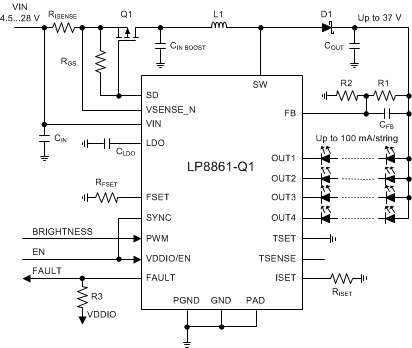 Figure 24. Typical Application for Four Strings 100 mA/String Configuration
Figure 24. Typical Application for Four Strings 100 mA/String Configuration
9.2.1.1 Design Requirements
| DESIGN PARAMETER | VALUE |
|---|---|
| VIN voltage range | 4.5…28 V |
| LED string | 4 x 8 LEDs (30 V) |
| LED string current | 100 mA |
| Max boost voltage | 37 V |
| Boost switching frequency | 300 kHz |
| External boost sync | not used |
| Boost spread spectrum | enabled |
| L1 | 33 μH |
| CIN | 10 µF 50 V |
| CIN BOOST | 2 × 10-µF, 50-V ceramic + 33-µF, 50-V electrolytic |
| COUT | 2 × 10-µF, 50-V ceramic + 33-µF, 50-V electrolytic |
| CLDO | 1 µF 10 V |
| CFB | 15 pF |
| RISET | 24 kΩ |
| RFSET | 210 kΩ |
| RISENSE | 50 mΩ |
| R1 | 750 kΩ |
| R2 | 130 kΩ |
| R3 | 10 kΩ |
| RGS | 20 kΩ |
9.2.1.2 Detailed Design Procedure
9.2.1.2.1 Inductor Selection
There are two main considerations when choosing an inductor; the inductor must not saturate, and the inductor current ripple must be small enough to achieve the desired output voltage ripple. Different saturation current rating specifications are followed by different manufacturers so attention must be given to details. Saturation current ratings are typically specified at 25°C. However, ratings at the maximum ambient temperature of application should be requested from the manufacturer. Shielded inductors radiate less noise and are preferred. The saturation current must be greater than the sum of the maximum load current and the worst-case average to peak inductor current. Equation 10 shows the worst-case conditions:
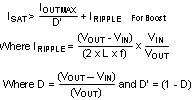
where
- IRIPPLE - peak inductor current
- IOUTMAX - maximum load current
- VIN - minimum input voltage in application
- L - min inductor value including worst case tolerances
- ƒ - minimum switching frequency
- VOUT - output voltage
- D - Duty Cycle for CCM Operation
- VOUT - Output Voltage
As a result the inductor should be selected according to the ISAT. A more conservative and recommended approach is to choose an inductor that has a saturation current rating greater than the maximum current limit. A saturation current rating at least 3 A is recommended for most applications. See Table 2 for inductance recommendation for the different switch frequency ranges. The inductor’s resistance should be less than 300 mΩ for good efficiency.
See detailed information in Understanding Boost Power Stages in Switch Mode Power Supplies (SLVA061). Power Stage Designer™ Tools can be used for the boost calculation: http://www.ti.com/tool/powerstage-designer.
9.2.1.2.2 Output Capacitor Selection
A ceramic and electrolytic capacitors should have sufficient voltage rating. The DC-bias effect in ceramic capacitors can reduce the effective capacitance by up to 80%, which needs to be considered in capacitance value selection. Capacitance recommendation for different switching frequency range is shown in Table 2. To minimize audible of noise ceramic capacitors their geometric size is usually minimized.
9.2.1.2.3 Input Capacitor Selection
A ceramic and electrolytic capacitors should have sufficient voltage rating. The DC-bias effect in ceramic capacitors can reduce the effective capacitance by up to 80%, which needs to be considered in capacitance value selection. Capacitance recommendation for different switching frequency range is shown in Table 2. To minimize audible of noise ceramic capacitors their geometric size is usually minimized.
9.2.1.2.4 LDO Output Capacitor
A ceramic capacitor with at least 10-V voltage rating is recommended for the output capacitor of the LDO. The DC-bias effect in ceramic capacitors can reduce the effective capacitance by up to 80%, which needs to be considered in capacitance value selection. Typically a 1-µF capacitor is sufficient.
9.2.1.2.5 Diode
A Schottky diode should be used for the boost output diode. Ordinary rectifier diodes should not be used, because slow switching speeds and long recovery times degrade the efficiency and the load regulation. Diode rating for peak repetitive current should be greater than inductor peak current (up to 3 A) to ensure reliable operation. Average current rating should be greater than the maximum output current. Schottky diodes with a low forward drop and fast switching speeds are ideal for increasing efficiency. Choose a reverse breakdown voltage of the Schottky diode significantly larger than the output voltage.
9.2.1.2.6 Power Line Transistor
A pFET transistor with necessary voltage rating (VDS at least 5 V higher than max input voltage) should be used. Current rating for the FET should be the same as input peak current or greater. Transfer characteristic is very important for pFET. VGS for open transistor must be less than VIN. A 20-kΩ resistor between pFET gate and source is sufficient.
9.2.1.2.7 Input Current Sense Resistor
A high-power 50-mΩ resistor should be used for sensing the boost input current. Power rating can be calculated from the input current and sense resistor resistance value. Increasing RISENSE decreases VIN OCP current proportionally.
9.2.1.3 Application Curves
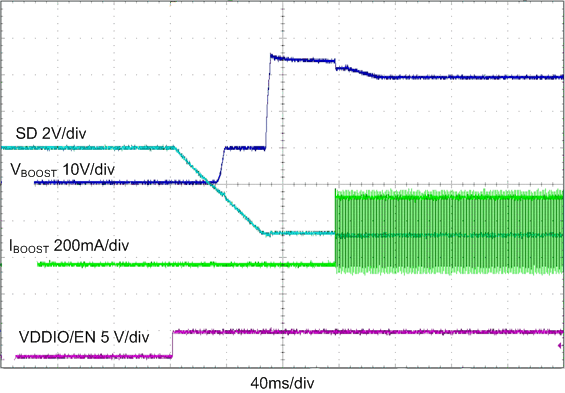
| ƒSW = 300 kHz | VIN = 10 V | |
| Brightness PWM 50% 100 Hz | ||
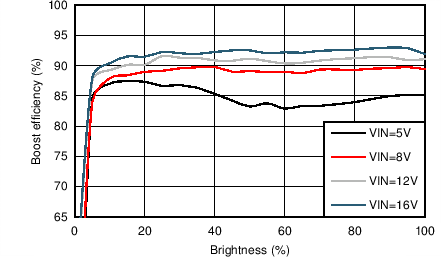
| Load 4 strings, 8 LED per string | ƒSW= 300 kHz | |
| I = 100 mA/string for VIN = 12 V and 16 V | ||
| I = 60 mA/sting for VIN = 8 V | ||
| I = 50 mA/string for VIN = 5 V | ||
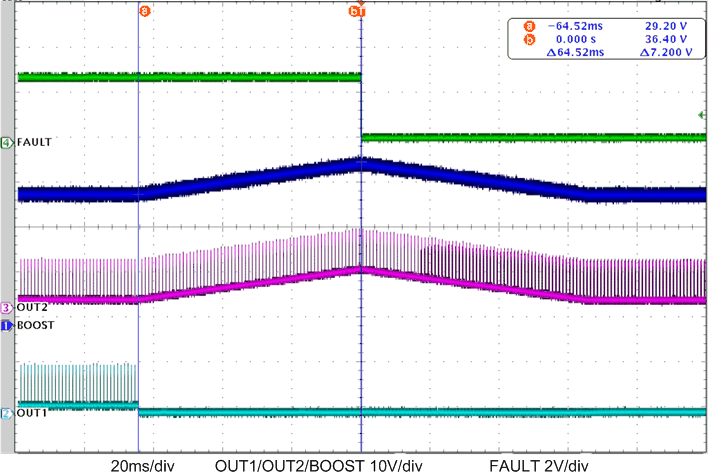
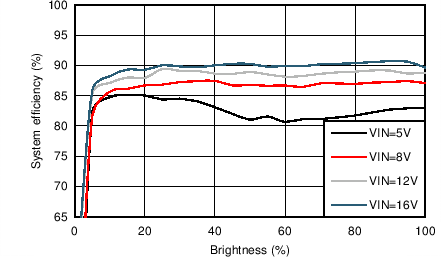
| Load 4 strings, 8 LED per string | ƒSW = 300 kHz | |
| I = 100 mA/string for VIN = 12 V and VIN = 16 V | ||
| I = 60 mA/sting for VIN = 8 V | ||
| I = 50 mA/string for VIN = 5 V | ||
9.2.2 High Output Current Application
The LP8861-Q1 current sinks can be tied together to drive LED with higher current. To drive 200 mA per string 2 outputs can be connected together. All 4 outputs connected together can drive an up to 400-mA LED string. Device circuitry is powered from external VDD voltage.
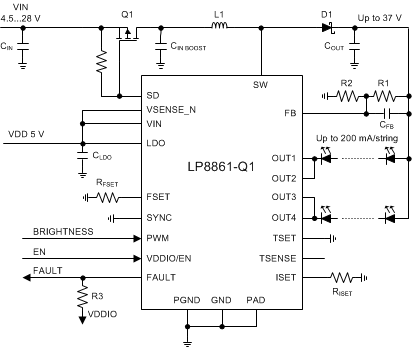 Figure 29. Two Strings 200 mA/String Configuration
Figure 29. Two Strings 200 mA/String Configuration
9.2.2.1 Design Requirements
| DESIGN PARAMETER | VALUE |
|---|---|
| VIN voltage range | 4.5…28 V |
| LED string | 2 × 8 LEDs (30 V) |
| LED string current | 200 mA |
| Max boost voltage | 37 V |
| Boost switching frequency | 2.2 MHz |
| External boost sync | not used |
| Boost spread spectrum | disabled |
| L1 | 4.7 μH |
| CIN | 10 µF 50 V |
| CIN BOOST | 2 × 10-µF, 50-V ceramic |
| COUT | 3 × 10-µF, 50-V ceramic |
| CLDO | 1 µF 10 V |
| CFB | 4.7 pF |
| RISET | 24 kΩ |
| RFSET | 24 kΩ |
| R1 | 750 kΩ |
| R2 | 130 kΩ |
| R3 | 10 kΩ |
| RGS | 20 kΩ |
9.2.2.2 Detailed Design Procedure
9.2.2.3 Application Curves
See Application Curves.
9.2.3 SEPIC Mode Application
When LED string voltage can be above or below VIN voltage, SEPIC configuration can be used. The SW pin voltage is equal to the sum of the input voltage and output voltage in SEPIC mode — this fact limits the maximum input voltage in this mode. LED current sinks not used should be connected to ground. External frequency can be used to synchronize boost/SEPIC switching frequency, and external frequency can be modulated to spread switching frequency spectrum.
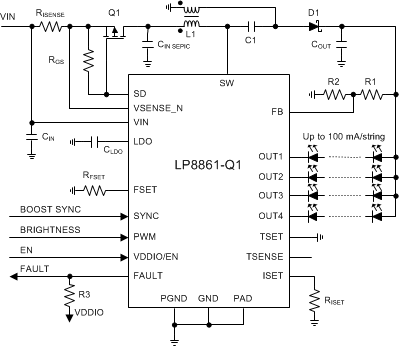 Figure 30. SEPIC Mode, 4 Strings 100 mA/String Configuration
Figure 30. SEPIC Mode, 4 Strings 100 mA/String Configuration
9.2.3.1 Design Requirements
| DESIGN PARAMETER | VALUE |
|---|---|
| VIN voltage range | 4.5…30 V |
| LED string | 4 × 4 LEDs (14.5 V) |
| LED string current | 100 mA |
| Max boost voltage | 17.5 V |
| Boost switching frequency | 300 kHz |
| External boost sync | used |
| Boost spread spectrum | not available with external sync |
| L1 | 33 μH |
| CIN | 10 µF 50 V |
| CIN SEPIC | 2 × 10-µF, 50-V ceramic + 33-µF 50-V electrolytic |
| C1 | 10-µF 50-V ceramic |
| COUT | 2 × 10-µF, 50-V ceramic + 33-µF 50-V electrolytic |
| CLDO | 1 µF 10 V |
| RISET | 24 kΩ |
| RFSET | 210 kΩ |
| RISENSE | 50 mΩ |
| R1 | 390 kΩ |
| R2 | 130 kΩ |
| R3 | 10 kΩ |
| RGS | 20 kΩ |
9.2.3.2 Detailed Design Procedure
See Detailed Design Procedure for external component recommendations. The Power Stage Designer™ Tools can be use for defining SEPIC component current and voltage ratings according to application: http://www.ti.com/tool/powerstage-designer
9.2.3.2.1 Diode
A Schottky diode with a low forward drop and fast switching speed should be used for the SEPIC output diode. Do not use ordinary rectifier diodes, because slow switching speeds and long recovery times degrade the efficiency and load regulation. The diode must be able to handle peak repetitive current greater than the integrated FET peak current (SW pin limit), thus 3 A or higher must be used to ensure reliable operation. Average current rating should be greater than the maximum output current. Choose a diode with reverse breakdown larger than the sum of input voltage and output voltage.
9.2.3.2.2 Inductor
Coupled or uncoupled inductors can be used in SEPIC mode. Coupled inductor typically provides better efficiency. Power Stage Designer™ Tools can be used for the SEPIC inductance calculation: http://www.ti.com/tool/powerstage-designer.
9.2.3.3 Application Curves
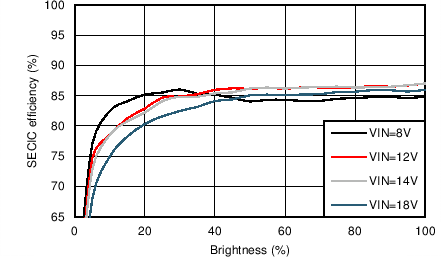
| Load 4 strings, 4 LED per string | ƒSW = 300 kHz | |
| I = 100 mA/string | ||
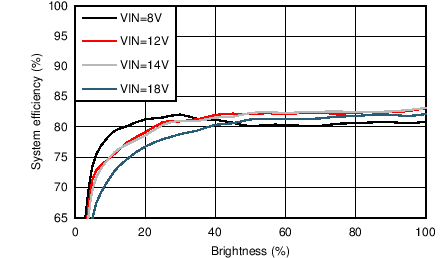
| Load 4 strings, 4 LED per string | ƒSW = 300 kHz | |
| I = 100 mA/string | ||
9.2.4 Application with Temperature Based LED Current De-rating
The LP8881-Q1 is able to protect connected LED strings from overheating. LED current versus temperature behavior can be adjusted with external resistor as described in LED Current Dimming With External Temperature Sensor.
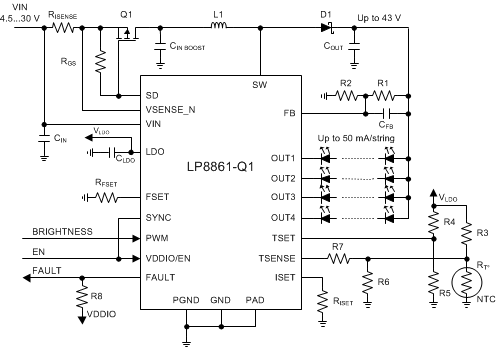 Figure 33. Temperature Based LED Current De-rating
Figure 33. Temperature Based LED Current De-rating
9.2.4.1 Design Requirements
| DESIGN PARAMETER | VALUE |
|---|---|
| VIN voltage range | 4.5…30 V |
| LED string | 4 × 9 LEDs (33 V) |
| LED string current | 50 mA |
| Max boost voltage | 43 V |
| Boost switching frequency | 400 kHz |
| External boost sync | not used |
| Boost spread spectrum | enabled |
| L1 | 33 μH |
| CIN | 10-µF 50-V ceramic |
| CIN BOOST | 2 × 10-µF, 50-V ceramic + 33-µF, 50-V electrolytic |
| COUT | 2 × 10-µF, 50-V ceramic + 33-µF, 50-V electrolytic |
| CLDO | 1 µF 10 V |
| CFB | 15 pF |
| RISET | 48 kΩ |
| RFSET | 160 kΩ |
| RISENSE | 50 mΩ |
| R1 | 866 kΩ |
| R2 | 130 kΩ |
| R3 | 12 kΩ |
| R4 | 10 kΩ |
| R5 | 1.8 kΩ |
| R6 | 82 kΩ |
| R7 | 16 kΩ |
| R8 | 10 kΩ |
| RT | 10 kΩ @ 25°C |
| RGS | 20 kΩ |
9.2.4.2 Detailed Design Procedure
9.2.4.3 Application Curve
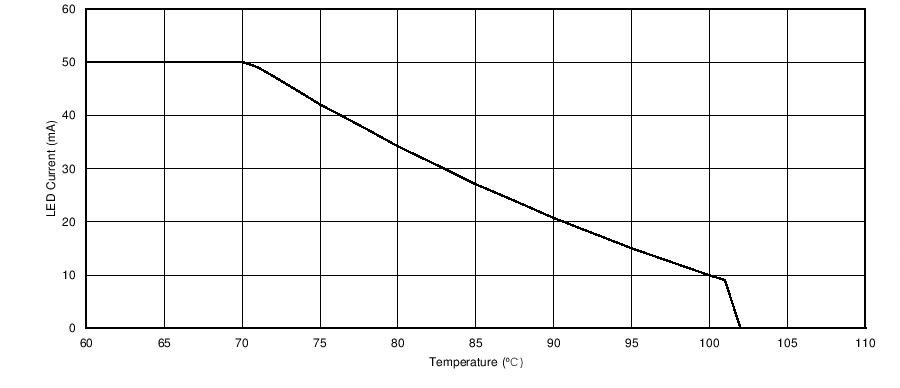 Figure 34. LED Current vs Temperature
Figure 34. LED Current vs Temperature